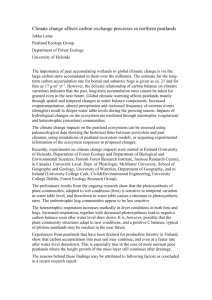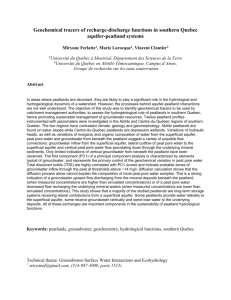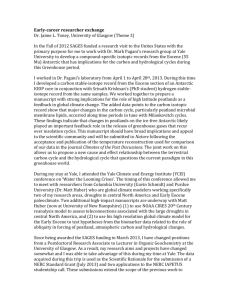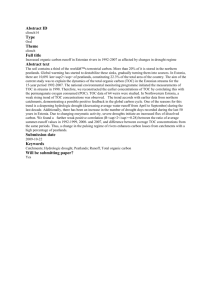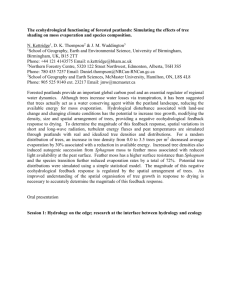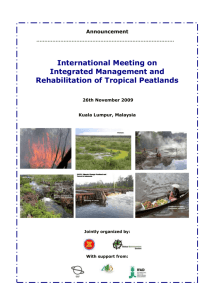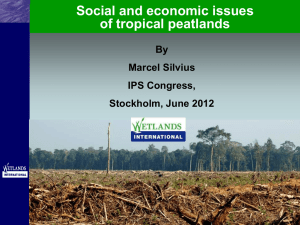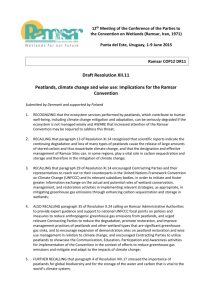DISCRIMINATION OF PEATLANDS AND MINERAL SOIL LANDS
advertisement
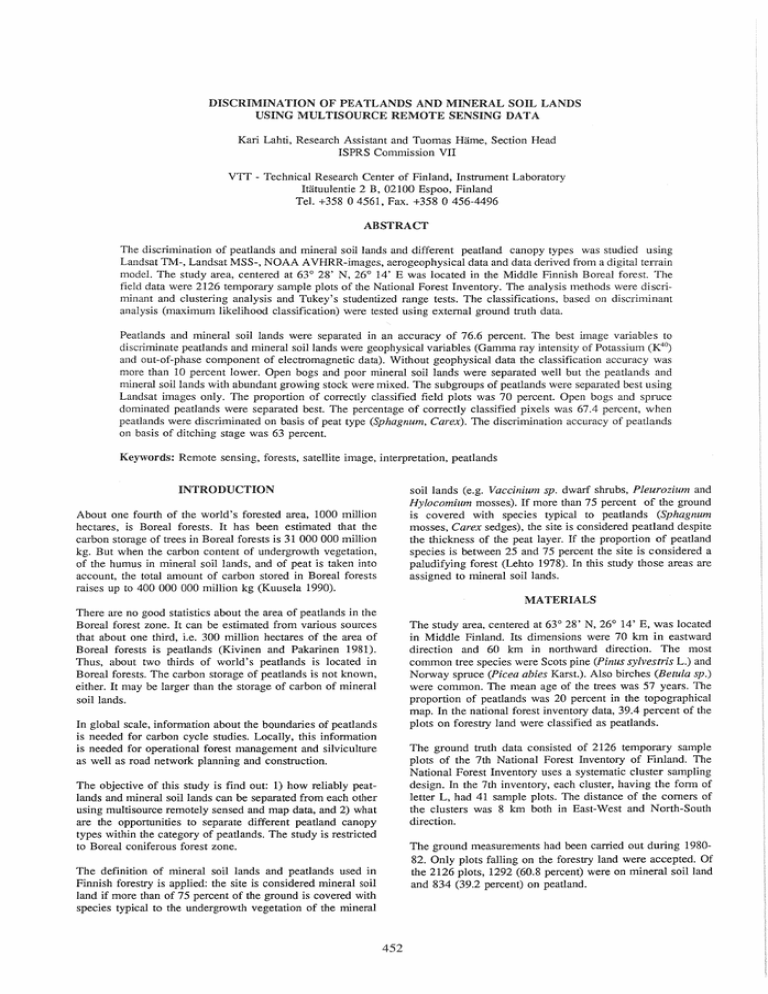
DISCRIMINATION OF PEATLANDS AND MINERAL SOIL LANDS
USING MULTISOURCE REMOTE SENSING DATA
Kari Lahti, Research Assistant and Tuomas Harne, Section Head
ISPRS Commission VII
VTT - Technical Research Center of Finland, Instrument Laboratory
Itatuulentie 2 B, 02100 Espoo, Finland
Tel. +358 04561, Fax. +358 0 456-4496
ABSTRACT
The discrimination of peatlands and mineral soil lands and different peatland canopy types was studied using
Landsat TM-, Landsat MSS-, NOAA AVHRR-images, aerogeophysical data and data derived from a digital terrain
model. The study area, centered at 63° 28' N, 26° 14' E was located in the Middle Finnish Boreal forest. The
field data were 2126 temporary sample plots of the National Forest Inventory. The analysis methods were discriminant and clustering analysis and Tukey's studentized range tests. The classifications, based on discriminant
analysis (maximum likelihood classification) were tested using external ground truth data.
Peatlands and mineral soil lands were separated in an accuracy of 76.6 percent. The best image variables to
discliminate peatlands and mineral soil lands were geophysical variables (Gamma ray intensity of Potassium (K40)
and out-of-phase component of electromagnetic data). Without geophysical data the classification accuracy was
more than 10 percent lower. Open bogs and poor mineral soil lands were separated well but the peatlands and
mineral soil lands with abundant growing stock were mixed. The subgroups of peatlands were separated best using
Landsat images only. The proportion of correctly classified field plots was 70 percent. Open bogs and spruce
dominated peatlands were separated best. The percentage of correctly classified pixels was 67.4 percent, when
peatlands were discriminated on basis of peat type (Sphagnum, Carex). The discrimination accuracy of peatlands
on basis of ditching stage was 63 percent.
Keywords: Remote sensing, forests, satellite image, interpretation, peatlands
INTRODUCTION
soil lands (e.g. Vaccinium sp. dwarf shrubs, Pleurozium and
Hylocomium mosses). If more than 75 percent of the ground
is covered with species typical to peatlands (Sphagnum
mosses, Carex sedges), the site is considered peatland despite
the thickness of the peat layer. If the proportion of peatland
species is between 25 and 75 percent the site is considered a
paludifying forest (Lehto 1978). In this study those areas are
assigned to mineral soil lands.
About one fourth of the world's forested area, 1000 million
hectares, is Boreal forests. It has been estimated that the
carbon storage of trees in Boreal forests is 31 000 000 million
kg. But when the carbon content of undergrowth vegetation,
of the humus in mineral soil lands, and of peat is taken into
account, the total amount of carbon stored in Boreal forests
raises up to 400 000 000 million kg (Kuusela 1990).
MATERIALS
There are no good statistics about the area of peatlands in the
Boreal forest zone. It can be estimated from various sources
that about one third, i.e. 300 million hectares of the area of
Boreal forests is peatlands (Kivinen and Pakarinen 1981).
Thus, about two thirds of world's peatlands is located in
Boreal forests. The carbon storage of peatlands is not known,
either. It may be larger than the storage of carbon of mineral
soil lands.
The study area, centered at 63° 28' N, 26° 14' E, was located
in Middle Finland. Its dimensions were 70 km in eastward
direction and 60 km in northward direction. The most
common tree species were Scots pine (Pinus sylvestris L.) and
Norway spruce (Picea abies Karst.). Also birches (Betula sp.)
were common. The mean age of the trees was 57 years. The
proportion of peatlands was 20 percent in the topographical
map. In the national forest inventory data, 39.4 percent of the
plots on forestry land were classified as peatlands.
In global scale, information about the boundaries of peatlands
is needed for carbon cycle studies. Locally, this information
is needed for operational forest management and silviculture
as well as road network planning and construction.
The ground truth data consisted of 2126 temporary sample
plots of the 7th National Forest Inventory of Finland. The
National Forest Inventory uses a systematic cluster sampling
design. In the 7th inventory, each cluster, having the fOlm of
letter L, had 41 sample plots. The distance of the corners of
the clusters was 8 km both in East-West and North-South
direction.
The objective of this study is find out: 1) how reliably peatlands and mineral soil lands can be separated from each other
using multi source remotely sensed and map data, and 2) what
are the opportunities to separate different peatland canopy
types within the category of peatlands. The study is restricted
to Boreal coniferous forest zone.
The ground measurements had been carried out during 198082. Only plots falling on the forestry land were accepted. Of
the 2126 plots, 1292 (60.8 percent) were on mineral soil land
and 834 (39.2 percent) on peatland.
The definition of mineral soil lands and peatlands used in
Finnish forestry is applied: the site is considered mineral soil
land if more than of 75 percent of the ground is covered with
species typical to the undergrowth vegetation of the mineral
452
The image variables were:
reflects the electrolytic conductivity of the soil. The
conductivity improves as the moisture content of the soil
increases. The texture of soil also affects the conductivity.
Fine textures have better conductivity than coarse textures.
The peat has better conductivity than typical Finnish mineral
soil, fine sand moraine.
Landsat MSS channels 1-4
Ratio MSS3/MSS2 (MSS32)
Ratio MSSl/MSS2 (MSS12)
The 1st and the 2nd principal components of the
four MSS channels
9) - 15) Landsat TM-channels 1-7
16)
Ratio TM4/TM3 (TM43)
Ratio TM2/TM3 (TM23)
17)
18) - 20) The first three principal components of the seven
TM channels
21) - 24) NOAA AVHRR channels 1-4
25)
Normalized Difference Vegetation Index
(NOAA2-NOAAl)j(NOAA2+NOAAl) (NDVI)
26)
Terrain elevation (Elev)
27)
Local terrain elevation calculated from (26)
28)
Terrain slope in eastward direction
calculated from (26)
29)
Terrain slope in northward direction
calculated from (26)
Gamma ray intensity from isotope K40 (potassium)
30)
using airborne measurements (GammaK)
Out-Of-Phase component of electromagnetic
31)
airborne measurements (O-O-P)
1) - 4)
5)
6)
7) - 8)
ANALYSIS
Discrimination of the following categories was studied:
1)
Peatland - Mineral soil land
2)
Subgroup of peatland (Spruce
dominated peatlands - Pine dominated
peatlands - Open bogs)
3)
Peat type of peatland (Sphagnum
dominated peat - Carex dominated
peat)
4)
Ditching stage of peatland (virgin ditched)
The principal components that were used in addition to the
original Landsat MSS and Landsat TM channels, were
computed from the four MSS channels and seven TM
channels using the correlation matrix of the channels. The
first two components of the MSS channels and the first three
components of the TM channels were further analyzed. The
ratios MSS3/MSS2, MSS 1/MSS2, TM4/TM3, and TM2/TM3
and the normalized difference vegetation index from the
NOAA AVHRR channels NOAAI and NOAA2 were also
computed.
All image variables were rectified to the uniform coordinate
system which is a Finnish coordinate system in Transverse
Mercator (Gauss-Krueger) projection. The applied pixel size
was 100 m x 100 m except for Landsat TM-image it was 30
m x 30 m. The selected pixel size was a compromise that
corresponded the true spatial resolution of most of the image
variables.
The intensity values of all image variables were selected for
ground sample plots by means of the map coordinates of the
plots.
The date of Landsat TM-image acquisition was June 20, 1990
and NOAA AVHRR-image was acquired in May 21, 1984.
Landsat MSS-image was a combination of several images.
The majority of images was acquired in June 17, 1986. In all
images the study area was cloud free.
The statistical analysis methods were Tukey's studentized
range tests, and discriminant and clustering analyses. The
SAS statistical software package was used. The depended
variables were the canopy types listed above. The independent
variables were the image variables. In discriminant analysis,
two procedures of SAS were used. The best discriminating
image variables were selected using the STEPDISC-procedure
(SAS Institute Inc. 1988). The final discriminant models were
computed using the DISCRIM procedure since separate
covariance matrices were used for image variables. Half of
the ground truth data was used for model construction and the
other half for testing in discriminant analyses.
Terrain elevation was acquired from a digitized topographic
map, scale 1:200 000 and contour interval 20 meters, through
interpolation. The topographical data were therefore quite
coarse. Local terrain elevation was defined as the elevation at
a pixel minus the average elevation in an 11 by 11 pixels
(1100 m by 1100 m) neighborhood of the central pixel.
Terrain slope in eastward direction was computed as the
derivative of terrain elevation in that direction. The northward
slope was computed similarly. Both derivatives were estimated as simple differences in a 3 by 3 pixels window (Hame et
al. 1991).
The FASTCLUS procedure that places observations into
clusters on the base of the Euclidean distances, was used in
clustering experiments. The image variables were clustered
and the content of the chlsters was obtained using the ground
truth data. The data set was divided into ten clusters in all
analyses. The amount of clusters was selected basing on
preliminary clustering analyses. The input image variables
both in discriminant and clustering analyses were standardized
to same mean and standard deviation before performing the
analysis.
The aerogeophysical data (variables 30 and 31) were acquired
using low-altitude (30-50 m) airborne measurements. The
distance between parallel flight lines had been 200 m and the
distance between the measurement points had been
approximately 50 m. The measurement results were
interpolated to raster format.
The Tukey's tests and discriminant analysis could be used to
select the best independent image variables. However, the
accessibility of the image variables varies. Therefore
discriminant models were also computed and tested for image
variable sets where the image variables had been selected on
the base of their accessibility. First, only NOAA data were
used. In final phase, the aerogeophysical variables were taken
to the model.
The gamma ray data were measured from the emittance range
of the K40 isotope. K40 is the most prominent source of
gamma radiation in ground. The registered radiation originates
from the top layer of the ground. Wet and moist areas have
usually low gamma ray intensities because water absorbs
gamma radiation very effectively (Kuittinen 1988).
The out-of phase component of the electromagnetic data
453
RESULTS
12
10
- - mineral soil land
Peatland - Mineral soil land
•••..•• pe.tI.nd
Gamma radiation was superior to the other image variables to
separate mineral soil lands and peatlands. The intensities of
gamma radiation were, on average, lower from peatlands than
from the mineral soil lands (Fig. 1). The other image
variables, significant with the 1 percent significance level,
were: out-of-phase component of the electromagnetic
measurements, ratio TM2/fM3, and absolute elevation. The
intensities of the out-of-phase component indicated a higher
electrolytic conductivity on peatlands than on the mineral soil
lands. The ratio green light/red light (TM2!fM3) was lower
on the peatlands and the peatlands were on average located on
higher elevations than the mineral soil lands. The differences
in the intensities of the Landsat TM channels were very small
in this test where all mineral soil lands were in one category
and all peatlands in another category.
... - ....... - ..
0.6
0.8
1.0
1.2
1.4
1.6
1.8
equivalent concentration of K (%EK)
Fig. 1. The frequency distribution of gamma ray intensities in
mineral soil lands and peatlands.
The ground truth plots were also divided into three coarse
biomass classes (Harne 1991) using the intensities of the
Landsat TM channel 3, the red light channel:
1)
2)
3)
4)
5)
6)
Mineral soil lands, TM3 < 21
Mineral soil lands, 21 <= TM3 < 31
Mineral soil lands, TM3 => 31
Peatlands, TM3 < 21
Peatlands, 21 <= TM3 < 31
Peatlands, TM3 => 31
TMI
TM2
TM3
TM4
TM5
TM7
Fig. 2. The Landsat TM intensities by mineral soil land and
peatland classes that are formed using the red light channel of
TM.
After this deviation could be seen that in categories with tree
cover (classes 1, 2, 4, and 5) the intensities of mineral soil
lands and peatlands are very similar (Fig. 2). The open
mineral soil lands and peatlands (classes 3 and 6) differ more
from each other. The result was confirmed in discriminant and
clustering analyses: peatlands with tree cover were mixed
with the mineral soil lands, but open bogs could be separated
using Landsat TM data only. The open bogs had lower near
infrared intensities but higher middle infrared intensities than
open mineral soil lands.
Figure 5 indicates how the classification performance greatly
improved when geophysical variables are included.
Discrimination of subgroups of peatlands
The best variables to separate the three peatland canopy types
or peatland subgroups were TM43 , TM3, TM5, TM23 and
MSS32. Those spectral features were also significant with 1
percent significance level to separate all subgroup
combinations in Tukey's tests. The red light and middle
infrared intensities were higher on open bogs than on
peatlands with tree cover. The pine dominated peatlands were
separated best from the spruce dominated peatlands
particularly due to their lower near infrared intensities and
higher visible and middle infrared intensities. This was caused
by the lower tree biomass on pine dominated peatlands
(visible and middle infrared) and higher proportion of
deciduous trees on spruce dominated peatlands (near infrared).
The gamma radiation data (GammaK) was very useful to
separate spruce dominated forests from pine dominated forests
and open bogs.
When a discriminant model was computed and tested using
best nine image variables, GammaK, O-O-P, NOAA2, Elev,
MSS32, TM43 , TM23, TM3 and MSS2, the percentage of
correctly classified ground plots of the external test data set
was 74.1 percent. Figure 3 shows the classification result and
Figure 4 the peadand mask of the topographical map 1 : 100
000. The discriminant model was also computed using
variables GammaK and O-O-P only. The proportion of
correctly classified ground plots was even slightly better (76.6
percent). If the image variables were TM channels only, the
percentage of correctly classified plots was 62.9. The
clustering also showed that geophysical variables prevent
treeless mineral soil land sites mixing with poor and treeless
peatlands.
In classifications to the three peatland subgroups, based on
discriminant analysis, the overall performance was 70 percent
(Table 1). Both discriminant and clustering analysis indicated
that spruce dominated peatlands and open bogs were
separated quite well while pine dominated peatlands were
mixed mainly to spruce dominated peatlands.
The discriminant analysis was also carried out so that only the
unditched or virgin peatlands represented the peatland
category. The purpose was to find out whether the ditching
had an effect on discrimination. Virgin open bogs and pine
dominated peatlands were separated very well from the
mineral soil lands while spruce dominated peatlands were
mixed with mineral soil lands. Most of the virgin peatlands in
the study area were rich spruce dominated forests.
454
Table 1. Test result of the classification to peatland
subgroups. External test data. Image variables TM43, TM3,
TM5, TM23, and MSS32.
classified into
spruce dominated
from
open bogs
IOlal
spruce
dominated
peatlands
126
27
10
163
77.30
16.56
6.13
100.00
pine
dominaled
peatlands
65
106
22
193
33.68
54.92
11040
100.00
open bogs
I
I
7
9
11.11
11.11
77.78
100.00
192
134
39
365
52.60
36.71
10.68
100.00
error
0.2270
0.4508
0.2222
0.3000
priors
0.33
0.33
0.33
tola!
Fig. 3. Maximum likelihood classification of the 70 km by 60
km study area to peatlands (grey) and mineral soil lands
(white) using best nine image variables. Waters are black.
pine dominated
Peat type
The type of peat reflects the amount of nutrients in the peat.
Carex species dominated peatlands usually indicate high
nutrient levels, while Sphagnum peat dominated sites are poor
of nutrients. The image variables that were significant in 1
percent significance level to separate the peat type were the
ratio near infrared/red of MSS (MSS32), TM4, the second
principal component of TM (TMPC2), and GammaK. The
majority of variation in TMPC2 was explained by the near
infrared channel of Landsat TM (TM4). Peatlands with Carexpeat had higher intensities in near infrared than peatlands with
Sphagnum-peat. The percentage of correctly classified pixels
in discriminant analysis was 67.4 percent. According to
clustering analysis peatlands could not be separated on ground
of peat type.
CONCLUSIONS
From the point of view of carbon storage estimation the most
important task is to separate open bogs and pine dominated
peatlands from mineral soil lands since they have the highest
storage of carbon. On spruce dominated peatlands the peat
layer is usually thinner and much bigger part of the carbon is
in trees.
Fig. 4. Mask of peatlands from the 1 : 100 000 topographical
map. Waters from the Landsat data.
50
45
~
§
40
30
{l
25
]
20
]
.~
Peatlands could not be separated from mineral soil lands very
reliably using spectral data only. However, the open bogs and
poorest pine dominated peatlands, i.e. the peatland types with
a high carbon storage, could be separated moderately. The
unditched pine dominated peatlands were also separated better
from the mineral soil lands than the ditched peatlands. The
middle infrared wavelength range seemed to be very
important. Note that the thermal data were not proven useful.
35
~
15
10
NOAA
NOAA+MSS
NOAA+MSS+
TM
NOAA+MSS+
TM+Topogr.
data
NOAA+MSS+
TM+Topogr.
data+Geophys.
data
The separation performance was much better when the
aerogeophysical data were used. Especially the gamma
radiation (GammaK) measurements were useful, because of
the absorption of gamma radiation caused by the water.
Fig. 5. Proportion of incorrectly classified test plots in
classifications using different image variable sets.
Classification mineral soil land/peatland.
To conclude, Landsat TM data only can be used in peatland
discrimination on areas with mostly virgin or unditched
peatlands. The best way for using the Landsat data may be
correcting and completing an actual mask of peatlands from
topographical maps. Airborne gamma radiation measurements,
if available, should be used. The resolution of NOAA
AVHRR is too a coarse for peatland separation in most cases.
Also the digital terrain model is not very useful because
455
peatlands often occur on areas where also mineral soil lands
are relatively even. The terrain model, if used, should be more
detailed than the model available in this study.
Kuusela, K. 1990. The dynamics of boreal coniferous forests.
Sitra 112. 172 p. ISBN 951-563-274-9, ISSN 0785-8388.
Lehto, J. 1978. Kaytannon metsatyypit
Kirjayhtyma. 98 p. ISBN 951-26-1479-0.
It was noteworthy that the definition of the peatland in the
topographical map and in forest inventory is different.
Seventy (70) percent of the plots classified as spruce
dominated peatlands in the national forest inventory were in
the mineral soil land category in the topographical map. It
would have been easier to separate the peatlands if the
definition of peatlands of the topographical maps were used.
(in
Finnish).
SAS Institute Inc. 1988. SAS/STAT User's Guide, Release
6.03 Edition. Cary, North Carolina, SAS Institute Inc. 1028 p.
The subgroups of peatlands were separated best using spectral
data only. This indicates that subgroups of peatlands differ
from each other mostly on basis of vegetation, not on ground
of moisture in the peat layer. Open bogs and spruce
dominated peatlands were separated well. The richer pine
dominated peatlands were mixed with spruce dominated
peatlands and the poorer pine dominated peatlands were
mixed with open bogs. The intensities of the red light as well
as the intensities of the middle infrared was clearly higher
from open bogs than from wooded peatlands. The peatlands
with Carex peat had a higher reflectance in the near infrared
than the peatlands with Sphagnum peat.
The difference may be partly caused by the tree species
proportions and partly by Carex and Sphagnum species and
other undergrowth vegetation. In peatlands with Carex-peat
the majority of undergrowth vegetation consists of sedges
(Carex) and herbs, that have a high reflectance in the near
infrared.
The ground truth data, although carefully measured, had some
drawbacks. The area represented by the sample plots was very
small when compared to the areas of the pixels in the image
data. The map coordinates of the plots were not very accurate.
No information about the location of the plots in respect to
the closest boundary of a canopy type was available. This
uncertainty most likely lead to too pessimistic results in the
image analysis. Some of the weaknesses of the national forest
inventory data have been corrected in the new inventory.
In the future work the suitability of radar images in
discrimination of peatlands and mineral soil lands should be
studied.
REFERENCES
Harne, T. 1991. Spectral interpretation of changes in forest
using satellite scanner images. Helsinki. Acta Forestalia
Fennica 222. 111 p. ISBN 951-651-092-2.
Harne, T., Salli, A, Rantala, 0., Ihalainen, A. 1991. Forest
growth conditions analysis using multiple source digital image
data. Proc. IGARSS'91 International Geosciences & Remote
Sensing Symposium, Espoo, Finland, June 3-6, 1991. 4 p.
Kivinen, E., Pakarinen, P. 1981. Geographical distribution of
peat resources and major peatland complex types in the world.
Finnish Academy of Science. Annales academiae scientarum
fennicae. Ser. A III 132.
Kuittinen, R. 1988. Determination of areal snow water
equivalent using satellite images and gamma ray spectrometry.
Acta Polytechnica Scandinavica. Ci 91. 139 p. ISBN 951-666275-7, ISSN 0355-2705.
456
